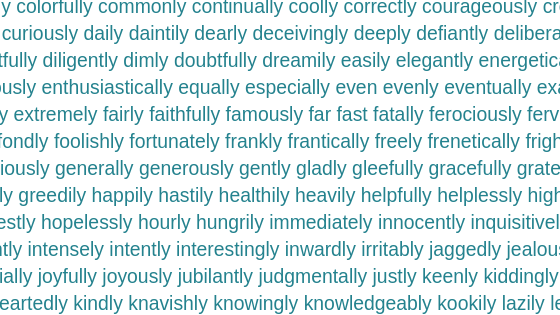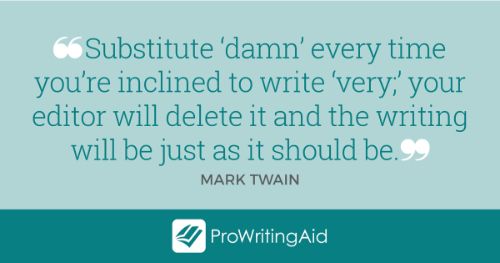Adverbs: Definition, Meaning, Usage and Examples
Adverbs are modifiers. They alter the meaning of words ‒ verbs, adjectives, other adverbs, and even whole sentences. Writers use adverbs to add color and refine meaning.
Examples of Adverbs
- Helen walked quickly to her next meeting. “Quickly” modifies the verb “walked.”
- She looked very comfortable in her knit dress. “Very” modifies the adjective “comfortable.”
- Unfortunately, we can’t make it to your wedding. “Unfortunately” modifies the entire sentence.

Many writers think of adverbs as the -ly words, but there are many without an -ly ending. Here are some common examples:
afterward, already, almost, back, better, best, even, far, fast, hard, here, how, late, long, low, more, near, never, next, now, often, quick, rather, slow, so, soon, still, then, today, tomorrow, too, very, well, where, yesterday
Most (but not all) adverbs end in -ly. Examples include quickly, helpfully, apprehensively, grumpily. The adverb adds more nuanced information to the verb.
- He gave her a ride home.
- He helpfully gave her a ride home.
- He apprehensively gave her a ride home.
- He grumpily gave her a ride home.
Each of those sentences paints a different picture because of the adverbs.
What is a Redundant Adverb?
An adverb is redundant if you use it to modify a verb with the same meaning in its definition.
- Tom shouted loudly at the taxi as it drove away.
It’s not possible to shout quietly, so the word loudly is redundant.
- Anna smiled happily as she ate her ice cream.
Again, if Anna is smiling, we already know that she is happy.
Here are a few more examples of adverbs that repeat the meaning of the verb they’re trying to modify:
- On the queen’s death, the throne reverts back to the next male in line.
- The spooked horse bolted hastily across the field.
- His unfortunate nose protruded out over his upper lip.
- Steve whispered quietly to Susie and then tiptoed soundlessly off.
All of those words can be removed without altering the meaning of the sentence.
Trim Your Adverbs
You can teach yourself to minimize adverbs by recognizing the proper times to use them.
First, eliminate redundant adverbs that are unnecessary and repeat what the verb means.
Here's an example: She smiled happily. The verb "smile" implies that she is happy. When someone smiles, they show happiness. If you want to emphasize her joy, try a stronger verb. She grinned. To learn more about using strong verbs in your writing, check out this post.
However, you can use an adverb to good effect if the situation is unusual for the verb, e.g. She smiled sadly. Here the adverb provides vital information: there are two contrasting emotions happening at the same time.
Do a search through your manuscript for all the adverbs. Check each one to make sure you need it in the sentence. Review your verb to think about replacing it with a stronger, more descriptive one; for example, grinned for smiled happily, stomped instead of walked angrily, etc.

Adverbs in Attribution
The words in the dialogue you write need to evoke the emotion of the character. Keep your attributions (also known as “dialogue tags”) short. Use “said,” “asked,” and “stated.” Keep your reader in the dialogue by minimizing attributions.
Eager writers are tempted to add adverbs to attributions. If you feel you need an adverb, rewrite the dialogue.
Example:
“I’ll never, ever talk to him again,” she said angrily.
The dialogue says it all – it's clear that she is angry with him. No need for the adverb.
The Just-Say-No Adverbs List
Certain adverbs have no place in narrative. If you find these adverbs, take them out. Adverbs to eliminate from your manuscript include:
- extremely
- definitely
- truly
- very
- really
Characters can use them in dialogue, but there’s no place for these adverbs in your narrative.

Adverbs in the Wrong Place
As you check your adverbs, you may decide that some will stay. Make sure those adverbs are in the right place in the sentence.
An adverb in a sentence with two verbs may be placed incorrectly.
Example:
He watched as she ran meditatively.
Readers will connect the adverb with the closest verb, so you want to make clear to your reader who is meditating.
Correction:
He watched meditatively as she ran.
One adverb that needs careful attention for placement is only. Use it after the verb and place it as close to the word it modifies as possible.
Grammar Girl uses grammarian James Kilpatrick’s example of how placing only changes the meaning of a sentence.
Only John hit Peter in the nose.
John hit only Peter in the nose.
John hit Peter only in the nose.
John only hit Peter in the nose.
The first sentence means John was the only person who hit Peter in the nose. In the second sentence, Peter is the sole recipient of the blow. In the third, Peter was hit in the nose but received no other blows or actions. And the fourth is open to interpretation. It could mean that John hit Peter in the nose but didn’t take any other actions or John hit Peter in the nose but did nothing else to it like pinch it.
When using only, make sure you know what you want to emphasize, then use the correct placement so that it’s clear to your reader.
When to Use Adverbs
Adverbs aren’t inherently good or bad: it’s all in how you use them. Let’s unpack when you should—and shouldn’t—use adverbs.
Use an adverb when…
1. It adds context or new information. For example, adverbs help you show time and place.
They went early to the nearby cinema to get tickets to the premiere.
The teacher rarely gives an "A" to anyone in her class.
A well-placed adverb can give emphasis to your meaning. Consider how a woman being late to her wedding differs from one who is intentionally late.
2. It can replace clunky phrasing.
CLUNKY: He patted her cheek in a rough manner.
SMOOTHER: He patted her cheek roughly.
3. Other words won’t work. Sometimes an adverb is exactly what you need. As smart as algorithms and machine learning code are, they cannot pick the right word every time. Only a writer or her editor can do that. That’s why writing is an art and not a science. Make sure you use adverbs sparingly and thoughtfully.
Replace an adverb when…
1. It restates part of the word it modifies or is redundant.
She whispered quietly to herself. Whispering is a quiet activity, so this adverb is redundant.
Tom gently caressed Sara’s shoulders. Caressing is always gentle, never rough.
2. It modifies a vague or weak verb.
- WEAK: Joshua called loudly for help as the water level rose quickly.
You can easily replace "called loudly" and "rose quickly" with stronger verbs that are more emotive.
- STRONGER: Joshua screamed for help as the water gushed in.
3. You use "very" or "really." What does "very" mean? Nothing solid, right? So whenever you feel obliged to drop in a "very" or a "really," find a stronger word than these weak amplifiers.
- instead of very large, try humongous or titanic
- in place of really small, use minuscule or microscopic
- replace very soft with faint or whispered
- rather than really loud, replace with piercing or cacophonous
How to Remove Adverbs From Your Writing
Worried that there are too many adverbs in your work? Most grammar checkers will miss adverbs, but ProWritingAid can help.